Cooking with Madame d’Aulnoy
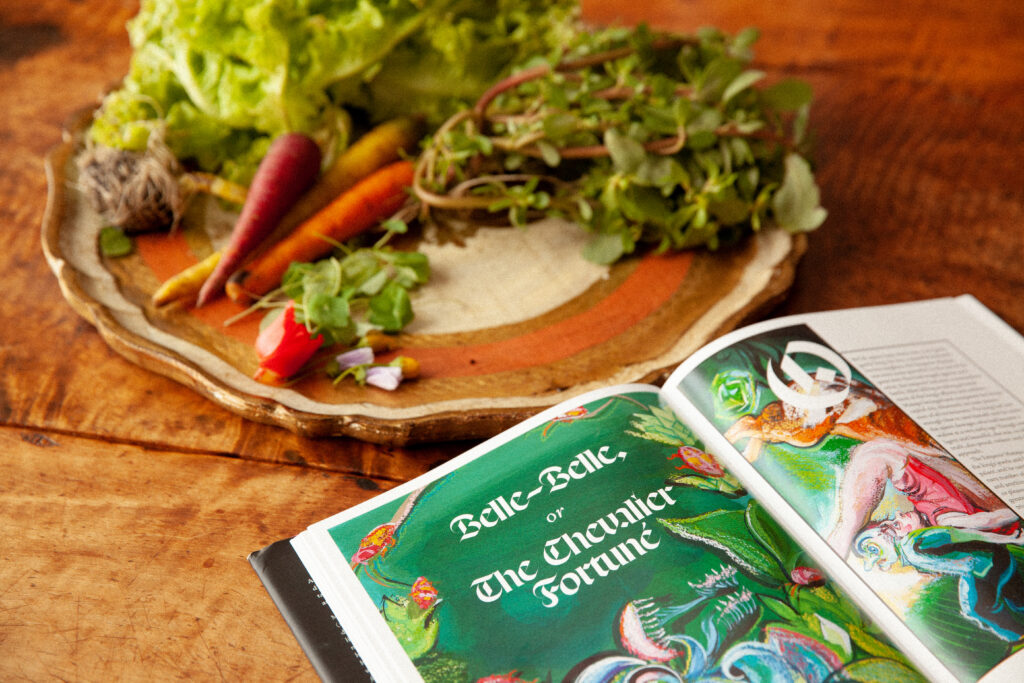
Photograph by Erica Maclean.
The fairy tales of Mary-Catherine le Jumel de Barneville, Baronesse d’Aulnoy—first published in French in the 1690s—are full of jewel-like foods, poisoned drinks, and violent feats of baking. The cooking is extreme. In one story, “Finette-Cendron,” a Cinderella figure, pleases her fairy godmother by baking her a cake with “two pounds of butter”; later, she serves her a feast made from two chickens, a cock, and “two little rabbits that were being fed up with cabbage.” In another story, “Belle-Belle,” a cross-dressing girl kills a dragon after getting him drunk on a lake-sized wine cocktail spiced with “raisins, pepper, and other things that cause thirst.” In a third, “The Bee and the Orange Tree,” a princess brings her shipwrecked sweetheart “four parrots and six squirrels cooked in the sun,” along with “strawberries, cherries, raspberries, and other fruit,” served on plates of stone, and using large, “very soft and pliable” leaves as napkins. Lest anyone find d’Aulnoy’s repasts and their power unrealistic, the opposite is true, as I discovered while attempting to re-create the food with my friend Celia Bell, whose novel, The Disenchantment, published this May, was inspired by d’Aulnoy’s life and work.
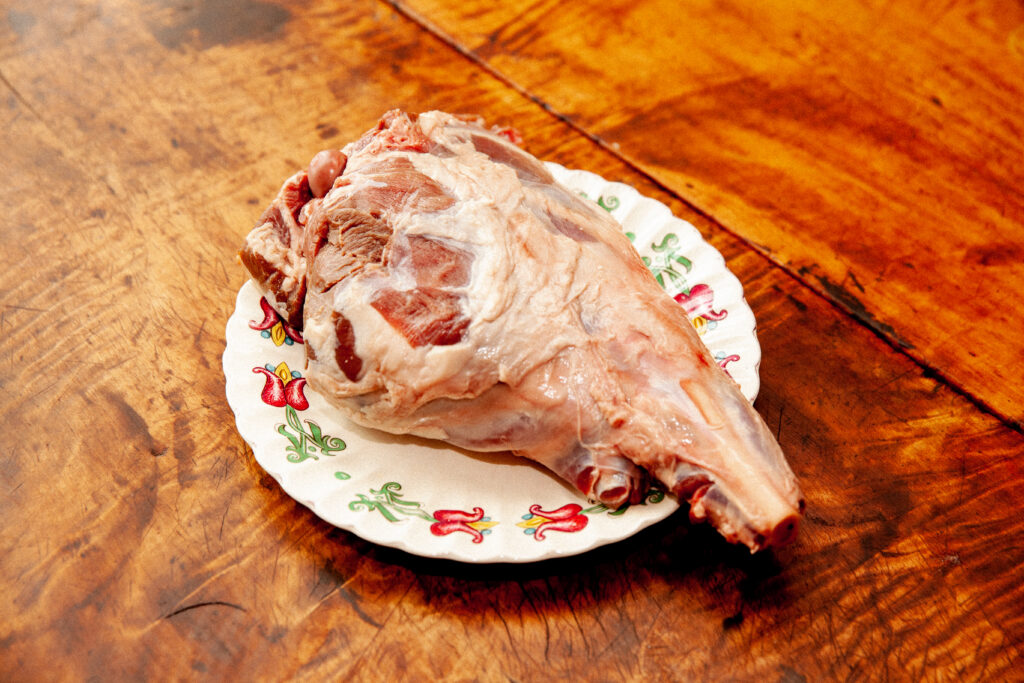
Our leg of lamb was big enough to feed an ogre. Photograph by Erica Maclean.
The Baronesse d’Aulnoy was an influential early author of fairy tales and a pioneer of the genre, who lived from the early 1650s until 1705, mostly in Paris. The term fairy tale itself is said to have come from her decision to call her works contes de fées (“fairy tales” in French). Despite the diamonds, ogres, fairies, and woodland adventures that populate her writings, d’Aulnoy was concerned with marriage and its consequences; the relation between the sexes; and female education, empowerment, independence, and sexuality. Her witty, aristocratic tales traffic in the kind of doublespeak inherent to fairy tales that allow their writers to uphold myths and social mores while also speaking “harsh truths” and “open[ing] spaces for dreaming alternatives,” as the writer Marina Warner puts it in her book of fairy-tale theory, From the Beast to the Blonde: On Fairy Tales and Their Tellers.
Read in this light, a story like “The Bee and the Orange Tree” reveals a subtext about female independence. In it, the shipwrecked Princess Aimée is raised by a family of ogres. When a handsome prince is also washed up onshore, the ogres want to eat him. Aimée saves his life, escapes the ogres (by baking a cake with a talking bean in it to distract them), and marries the prince in the end—a stock happy ending, due to her traditional virtues of sweetness, bravery, and goodness. But the meeting of the maiden and the ogre can also be read as a metaphor for marriage. Aimée is part of a “family” of cannibals, and is in constant danger of being consumed (as wives can be). She finds a beautiful and dazed young man washed up on the seashore, desires him, and takes action, ruthlessly killing the ogre-husband, tricking the witless ogre-wife, and incidentally killing a few ogre-children in order to escape.
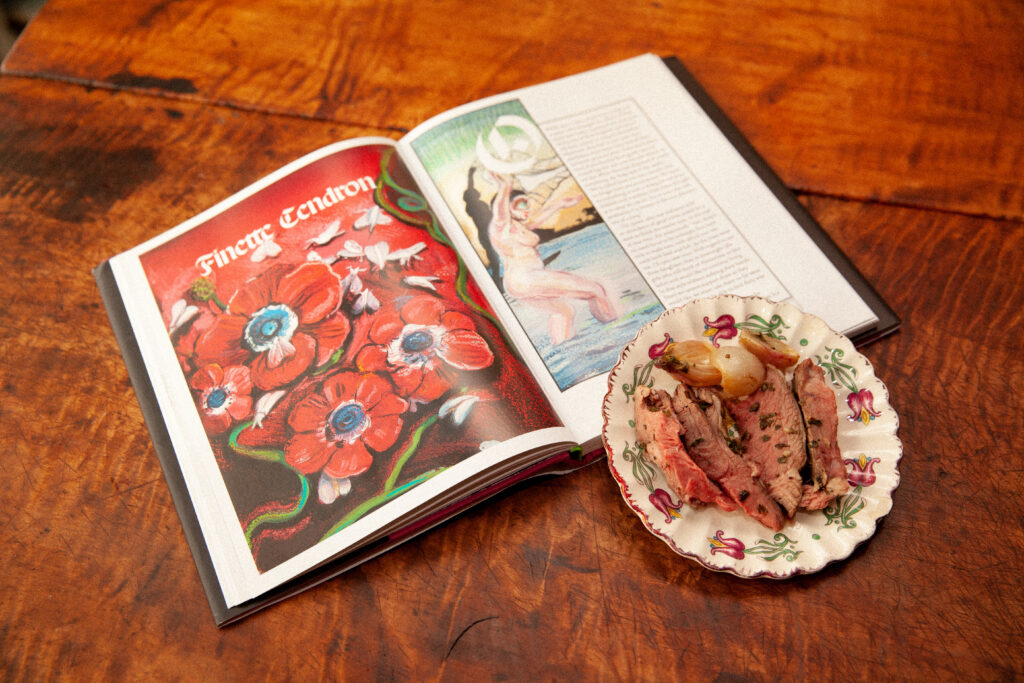
A 2011 illustrated edition of Madame D’Aulnoy’s selected tales, The Island of Happiness, with slices of the cooked leg of lamb. Photograph by Erica Maclean.
Celia’s novel, The Disenchantment, picks up on these themes from d’Aulnoy’s work and life. Celia’s heroine, Mary Catherine la Jumelle de Cardonnoy, struggles in an abusive marriage to an older man, trapped by her love for her two small children. The real Baronesse d’Aulnoy was married when she was fifteen years old to a man thirty years her senior, whom she schemed against with the help of her mother, and from whom she eventually managed to separate. D’Aulnoy might have had an affair with one (or both) of a pair of servants who helped her in the escape plot. Celia’s Mary Catherine is having an affair with a cross-dressing younger woman. When the ogre-like Baron d’Cardonnoy discovers them, the younger woman’s heroics place Mary Catherine in mortal peril, and the novel becomes a fairy tale in reverse, with the bride heading not into a marriage, but out of one.
I first read d’Aulnoy several years ago, at Celia’s suggestion, when I myself was unhappily married with two small children, and was considering my options. Somehow, divorce, which seemed like it should be emotionally and logistically possible for a woman in New York, was more daunting than I could have imagined. I was afraid of all the things women have always been afraid of. And also I was dismayed by how many things had gone wrong: a wife’s and a husband’s power to torture each other, the presence of unruly sexuality, the reality of raising children together that looked nothing like my dream. I appreciated d’Aulnoy’s stories for their ability to fully encompass the myths and ideals of marriage, while surprising me even four centuries later.
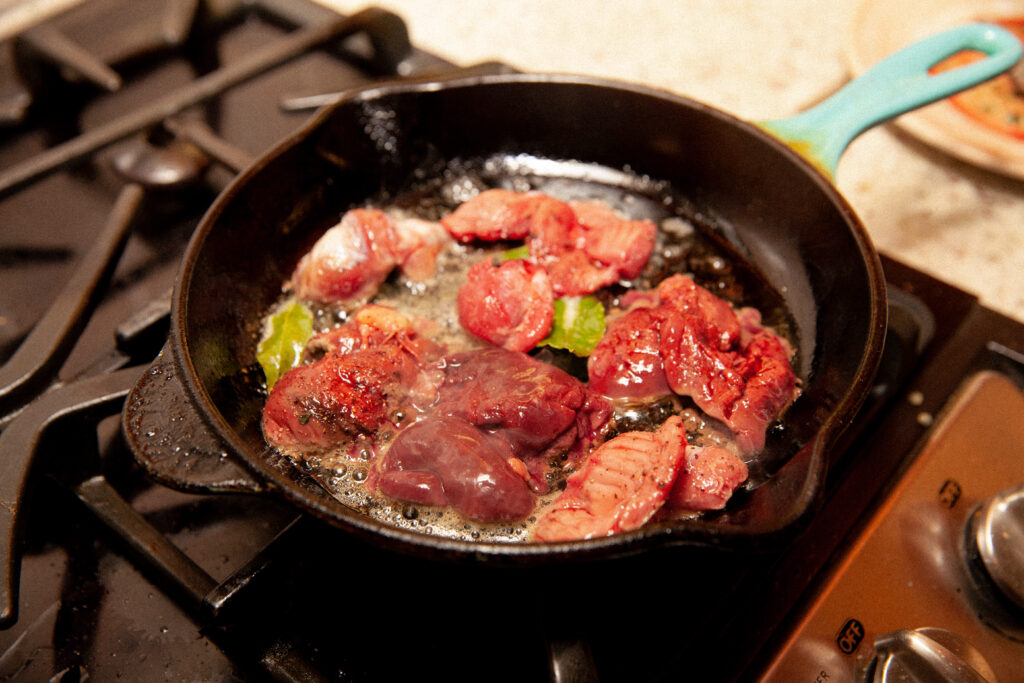
We made a Hunter’s Salad with chicken livers, inspired by the tale “The Hind in the Wood,” in which a hunter tracks his beloved, who has been turned into a deer. Photograph by Erica Maclean.
Celia and I got together in New York to make food from d’Aulnoy’s work, which had also made its way into her own writing. As part of writing her book, Celia had meticulously researched seventeenth-century food: that was the era, Celia told me, when French cooking as we know it today essentially developed. It was just becoming fashionable to cook fresh food, in season, simply prepared, and also to make the kind of elaborate pastries and extravagant centerpieces that we think of as quintessentially “French.” Celia saw parallels between the elaborate showmanship and pretend rusticism of the French cuisine of that period and our own trendy farm-to-table culture. Celia also pointed out the woodsiness that lived alongside all the finery: “Everyone is encrusted in carbuncles and diamonds, but also every so often someone has to run away and live picturesquely off the fruits of the forest.”
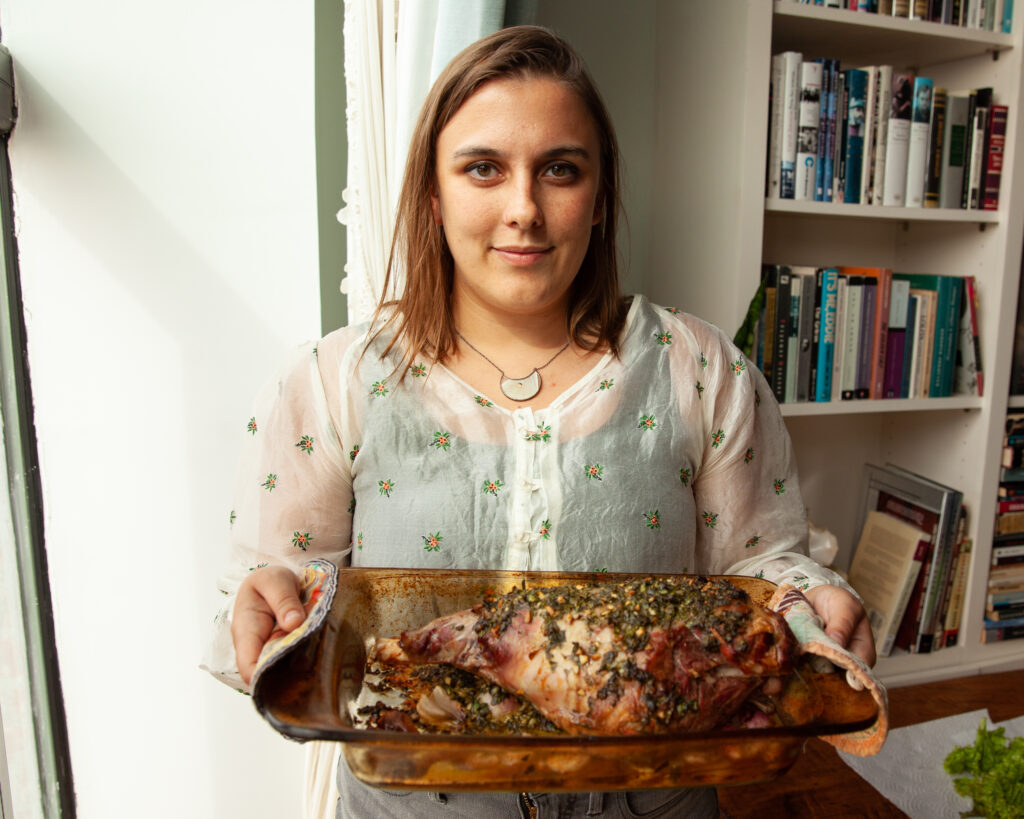
Celia Bell, whose novel, The Disenchantment, takes inspiration from the life of Madame d’Aulnoy. Photograph by Erica Maclean.
The story “The Hind in the Wood” provides a wonderful example of this kind of sophisticated faux rusticism. In it, Princess Desirée is lost in the woods, and has been cursed by a wicked lobster-fairy by being transformed into a white deer by day, only to resume her human form at night. Her beloved fiancé, Prince Warrior, does not realize that Desirée is the deer, and spends his days trying to track and shoot her. (And Desirée does not mind. A barbed reflection on love!) The forest setting and animal transformations are contrasted with the tale’s other features. By night, Desirée repairs to a charming cottage with her devoted maid, Gilliflower, where the two read books “to divert our minds.” Gilliflower conveniently runs over to the nearest town to buy the books. It sounds like a weekend in the Catskills.
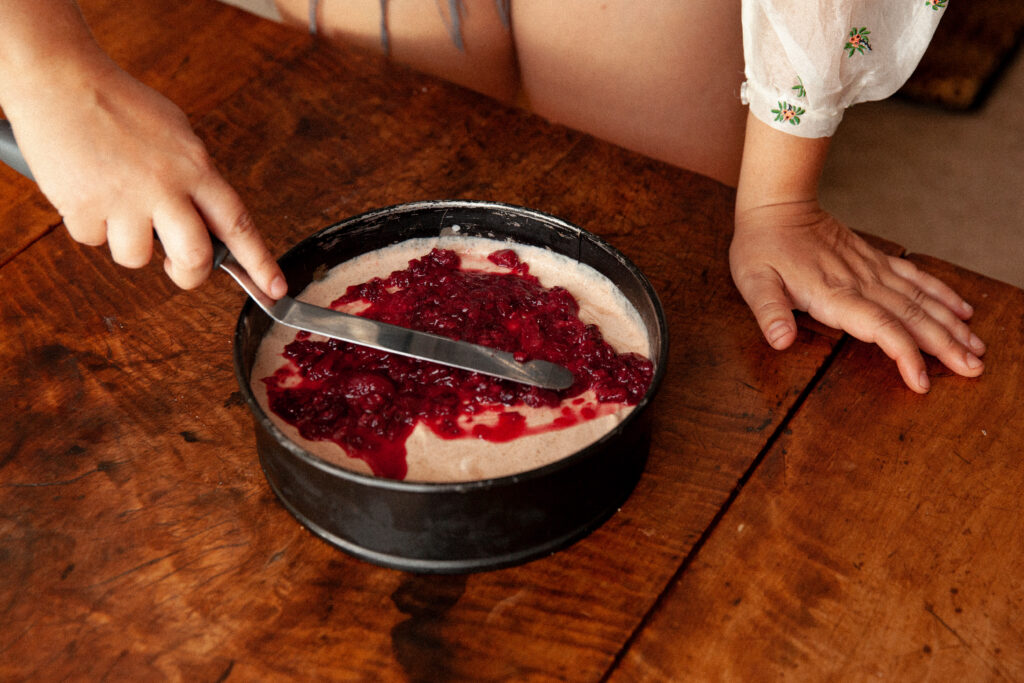
Celia spreads a layer of cherry jam on top of a mousse layer for the Princess Cake, so it will gush out like blood when the cake is cut. Photograph by Erica Maclean.
The menu Celia and I created, drawn from the four d’Aulnoy stories mentioned above, was classically French, but we adapted the recipes to incorporate some of the quasi-rusticism. It was almost too easy to do. Belle-Belle renders a dragon insensible with spiced wine, which made Celia think of a populo, a drink from the 1600s composed of wine spirits, musk, amber, pepper, oil of lemon, anise, and coriander. To make our version, Celia concocted her own oil of lemon infusion—a sweet, citrusy oleo-saccharum syrup, spiked with anise and coriander. My wine consultant, Hank Zona, suggested using a natural white wine from Corsican producer Yves Leccia as a base. (What better than a natural wine to epitomize rustic trendiness?) Hank also chose another beverage adhering to the old-is-new fad: a Blanquette de Limoux, from the French town where sparkling wine was invented in the 1530s, made in the méthode ancestrale, a close approximation of how it would have been made back then.
For our first course, Celia and I took inspiration from “The Hind in the Wood,” which ends with a protracted woodland idyll full of good things to eat. The characters in this story forage for food, nibbling on grass and eating apples with a beautiful “rosy color,” while listening to melodious birdsong. Today, diners at better restaurants, of course, often encounter foraged items on menus and will be familiar with this mood. Lacking a forest, Celia and I went to the farmers market and bought expensive microgreens (baby lettuces, nasturtium leaves, and purslane) and jewel-like edible flowers (we used Sichuan buttons, but pansies, marigolds, calendula, or bee balm would all be good). We tossed them with snipped parsley and the most French of herbs, tarragon, to make Salade Chasseur, traditionally a hunter’s foraged salad served with the offal from his kill. We topped our salad with savory wedges of chicken livers—the blood and guts as a contrast to the flowers and herbs seemed just right for a fairy tale.
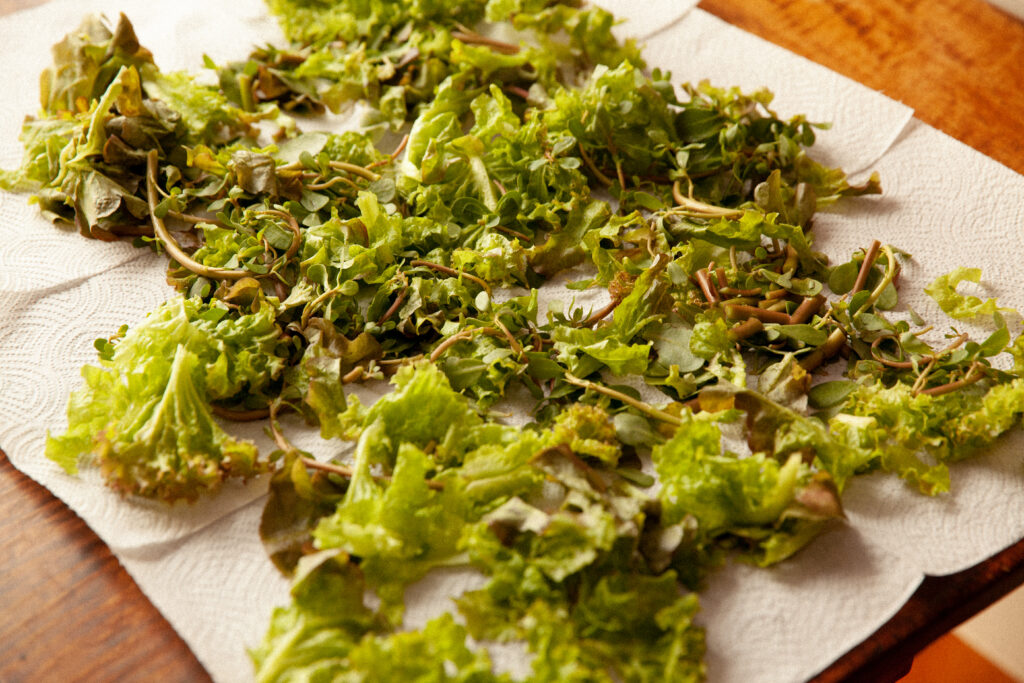
Microgreens from the farmers market, prior to their transformation into a Hunter’s Salad. Photograph by Erica Maclean.
Our main course was a roasted leg of lamb, or gigot, culled from the action in the story “Finette-Cendron.” D’Aulnoy’s version of the Cinderella tale includes an interlude in which the good Finette-Cendron and her two abusive sisters, Belle-de-Nuit and Fleur d’Amour, are captured by ogres. Her parents are spendthrifts and fools; even her fairy godmother insists that she behaves badly. Finette-Cendron refuses to be like them and acts according to her own conscience. When she encounters the ogres (a metaphorical family to mirror her real one), she ruthlessly dispatches them, pushing the ogre-husband into an oven and beheading his wife with an axe. D’Aulnoy rewards her with gold, jewels, and a handsome prince to love. Celia and I chose to reward our dinner guests with a repast from the ogre’s castle that would also be a nod to modern showmanship-cooking. The ogre is said to eat “a hundred lambs and a hundred sucking pigs” while waiting for Finette-Cendron to bake his bread. We made a massive leg of lamb, smothered in a butter-and-herb mixture.
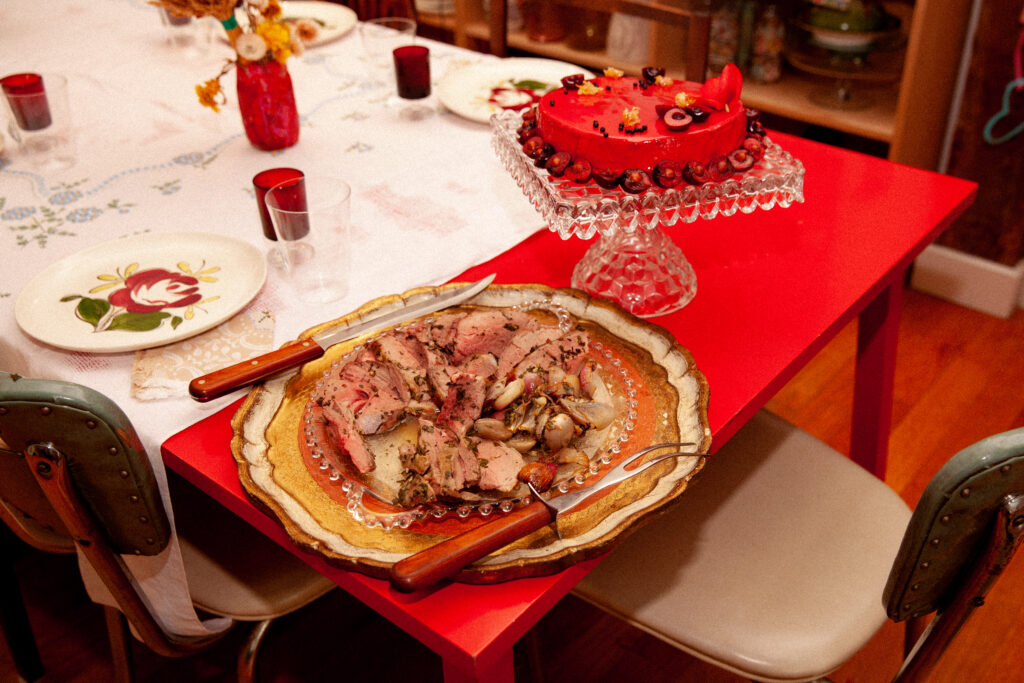
The bloodred glaze of the Cannibal Princess Cake hides three layers and a meaty surprise. Photograph by Erica Maclean.
Last, Celia designed a devious showstopper for dessert, a cake referencing the one Princess Aimée bakes to escape the cannibalistic ogres in “The Bee and the Orange Tree.” Aimée’s cake has a talking bean inside that misleads the ogres, giving her time to escape. Our cake was covered with a bloodred mirror glaze, to reference the ogres’ cannibalism, and contained an unexpected element not suitable for vegetarians, gelatin, for the same reason. It had so many steps and such laborious production techniques that it would provide a different kind of distraction, in order, Celia said, to keep the baker “away from whatever other responsibilities you have for some time.”
Fairy tales, according to Warner, have had staying power because they are essentially orderly. They draw boundaries, sorting out which behaviors are socially acceptable and which ones aren’t. D’Aulnoy’s heroines are unconventional, but their consoling magic is that they meet happy endings. And her achievement is that she made room for a wider range of characters to do so—unhappy wives, disobedient daughters, women who love to read. Our dinner party had a happy ending, as well, as we shared our food with our friends in my now-single-woman abode. Our cocktails were sweet, musky, and spicy, and we drank many of them. Celia turns out to be both a skilled writer of fairy tales and a dab hand at cooking challenging cuts of meat. Our lamb was tender and perfectly seasoned; the chunks of liver in the salad stole the show (both are items I’ve struggled to make correctly in the past). The Cannibal Princess Cake tasted of orange blossoms and cherries instead of human flesh, but we made-believe.
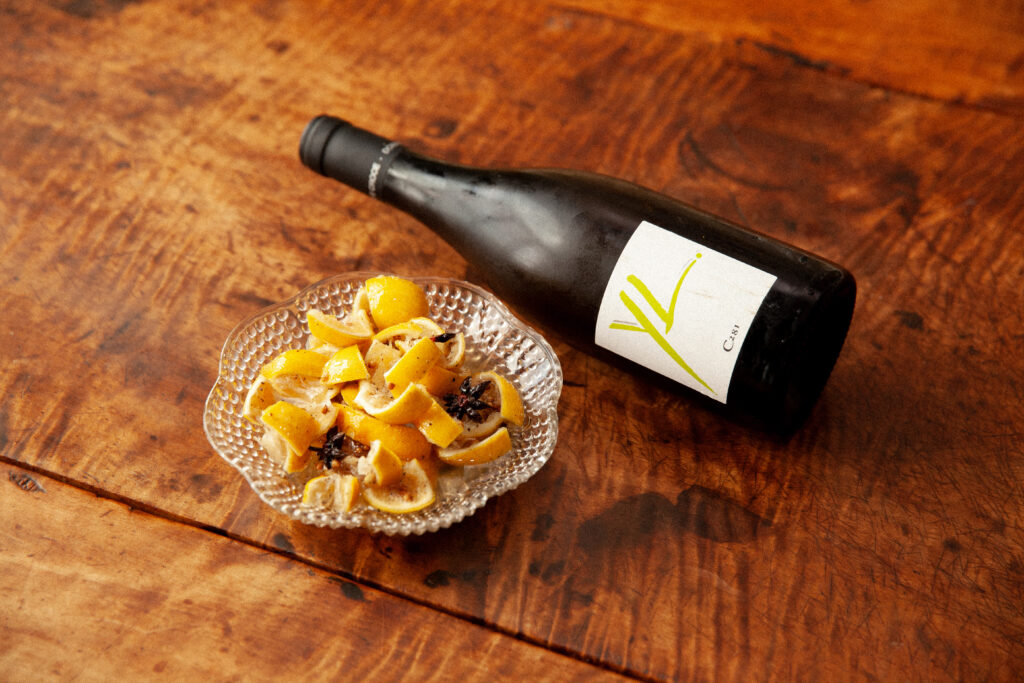
Photograph by Erica Maclean.
Populo from “Belle-Belle”
For the oleo-saccharum:
4–5 lemons
8 oz white sugar
1 tbsp freshly ground black pepper (or to taste)
3 star anise pods
1 tsp whole coriander
For the cocktail:
1 tbsp spiced oleo-saccharum
3 oz white wine
1 oz brandy
To make the oleo-saccharum, peel, halve, and juice the lemons. Coarsely chop the squeezed peels into bite-size pieces, then toss them with the lemon juice, sugar, and spices and leave to macerate overnight. Strain. For each cocktail, combine one tablespoon oleo-saccharum with the wine and brandy, shake over ice, strain, and serve.
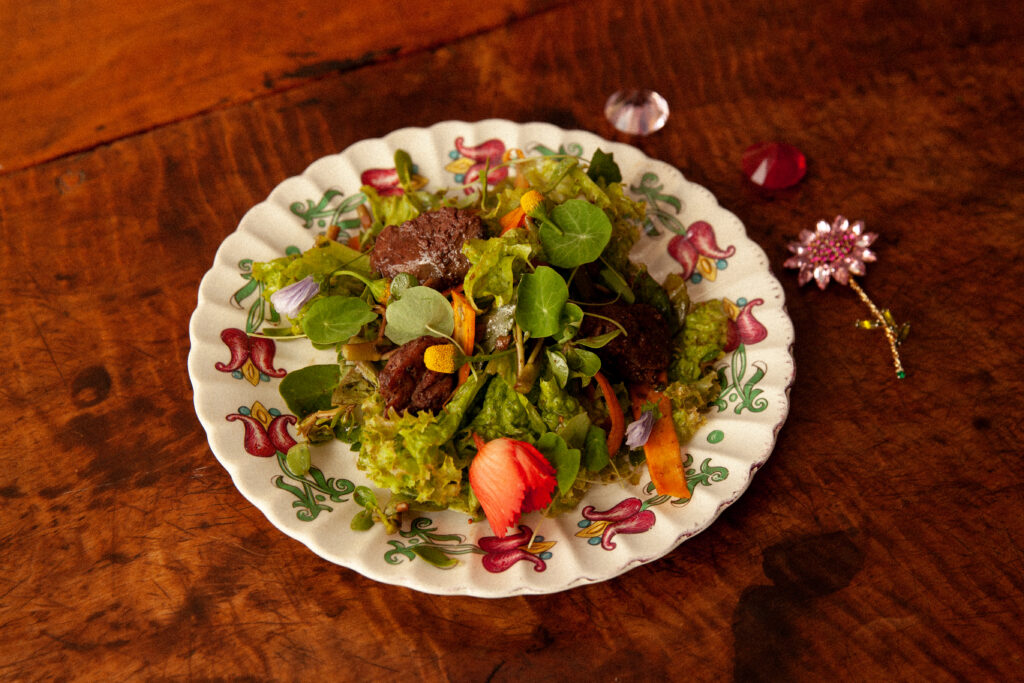
Photograph by Erica Maclean.
Salade Chasseur from “The Hind in the Wood”
For the livers:
1 sprig rosemary
1 bay leaf
1 pint chicken livers
Dash of cognac
For the dressing:
1/4 cup olive oil
1/4 cup vinegar
1 sprig tarragon, finely chopped
About 1/3 cup parsley, finely chopped
1 spoonful of Dijon mustard
Salt and pepper to taste
For the salad:
6 cups mixed greens
1 handful edible flowers
Choose your greens. If you have a garden, or a public park open to foragers, you might pick your own purslane—or wood sorrel, or bee balm, or lamb’s-quarter—but the salad will also be good if you use lettuce from the supermarket.
Make the livers. In a pan, heat a little olive oil and add the rosemary and bay leaf. Sauté until fragrant. Add the chicken livers and sauté on medium-high heat until they are cooked through or just pink in the middle. The texture of the livers should be creamy and firm. Transfer the livers to a plate and pour a dash of cognac into the pan to deglaze it. Reserve this liquid for your salad dressing.
Make the salad dressing. Finely chop the tarragon and parsley, then add to a bowl with the deglazed liquid from the pan you cooked the meat in, along with the olive oil and vinegar and Dijon mustard. Whisk, taste, and add salt and pepper and oil or vinegar to your liking.
To serve, toss the greens and flowers together with the dressing, and arrange the livers on top.
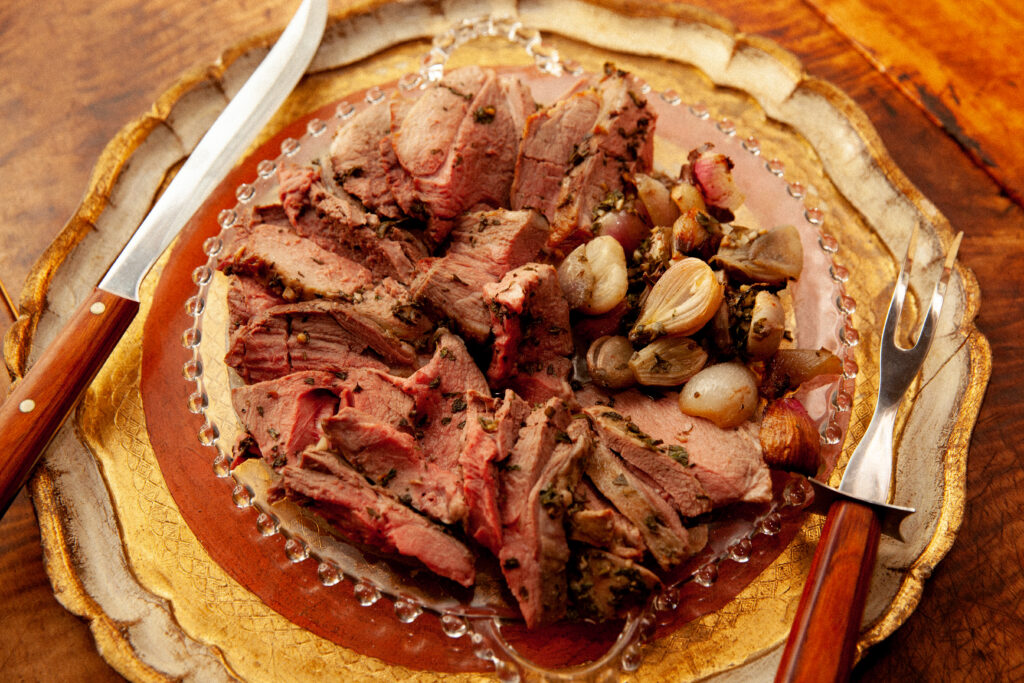
Photograph by Erica Maclean.
Le Gigot from “Finette-Cendron”
4–5 cloves garlic
1 tbsp chopped fresh rosemary
Zest of 1 lemon
1/2 stick softened butter
Salt and pepper to taste
Leg of lamb (gigot) (usually 4–5 lb)
2 onions
4–5 carrots
Finely chop the garlic, rosemary, and lemon zest, and mix into the softened butter, along with salt and pepper. Using a sharp knife, score the surface of the lamb in a crosshatched pattern, then coat it thoroughly with the butter-and-herb mixture.
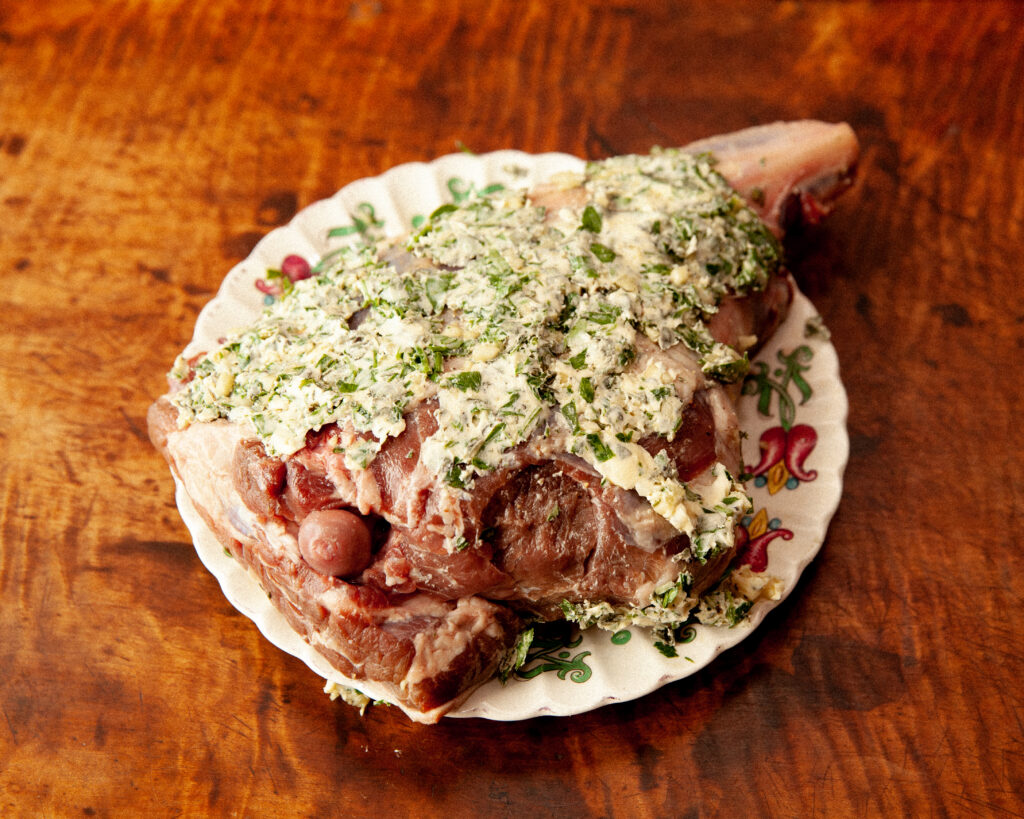
Photograph by Erica Maclean.
Heat the oven to 425°F. Peel and chop the onions and carrots, then place them in your baking dish with the lamb on top. Roast the lamb for fifteen minutes, then reduce the heat to 350°F and roast until the internal temperature reaches 130°F—usually for between an hour and an hour and a half, depending on the size of your gigot. Baste the lamb with its juices every fifteen to twenty minutes. When the internal temperature has reached 130°F, remove it from the oven and allow it to rest for ten minutes before carving. Slice thinly and serve with the roasted carrots and onions.
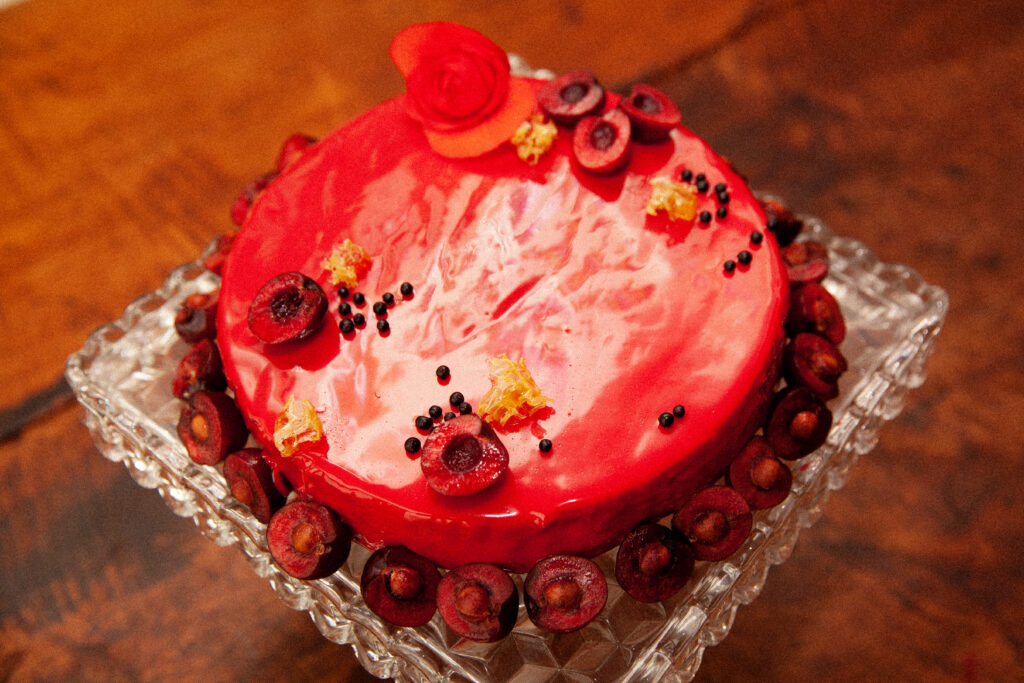
Photograph by Erica Maclean.
Cannibal Princess Cake from “The Bee and the Orange Tree”
For the mousse:
1 lb cherries, pitted
2 tbsp sugar
Dash of liquid from good-quality maraschino cherries, or substitute cognac
2 egg yolks (save whites for the cake layer)
100 g sugar
2 packets gelatin
40 ml water
200 g heavy cream
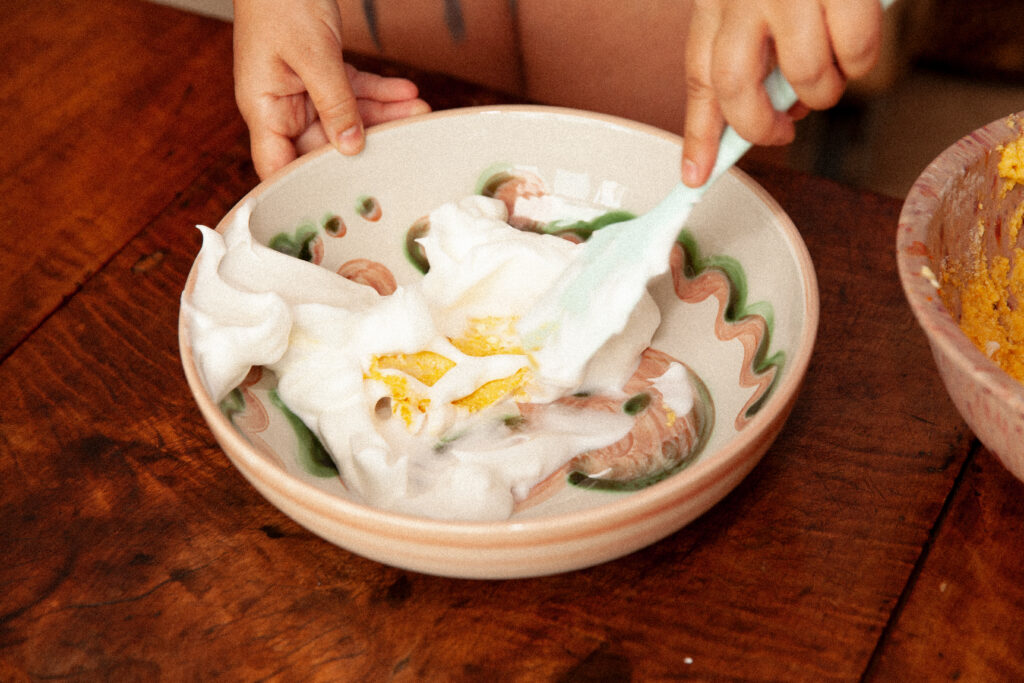
Photograph by Erica Maclean.
For the cake:
2 large egg whites
1 pinch cream of tartar
1 tbsp powdered sugar
3 medium eggs
75 grams granulated sugar
80 grams butter, room temperature
1/2 tsp orange blossom water
Zest of 1 orange
130 grams almond meal
50 grams all-purpose flour
Pinch of salt
For the mirror glaze:
1 tsbp plus 2 tsp gelatin, divided
1/4 cup cold water
2/3 cup condensed milk
1/2 cup plus 2 tbsp water
2 1/3 cups chopped white chocolate, or white chocolate chips
Red food coloring
To garnish:
Cherries or other red fruit
Comb honey
Red and white flowers
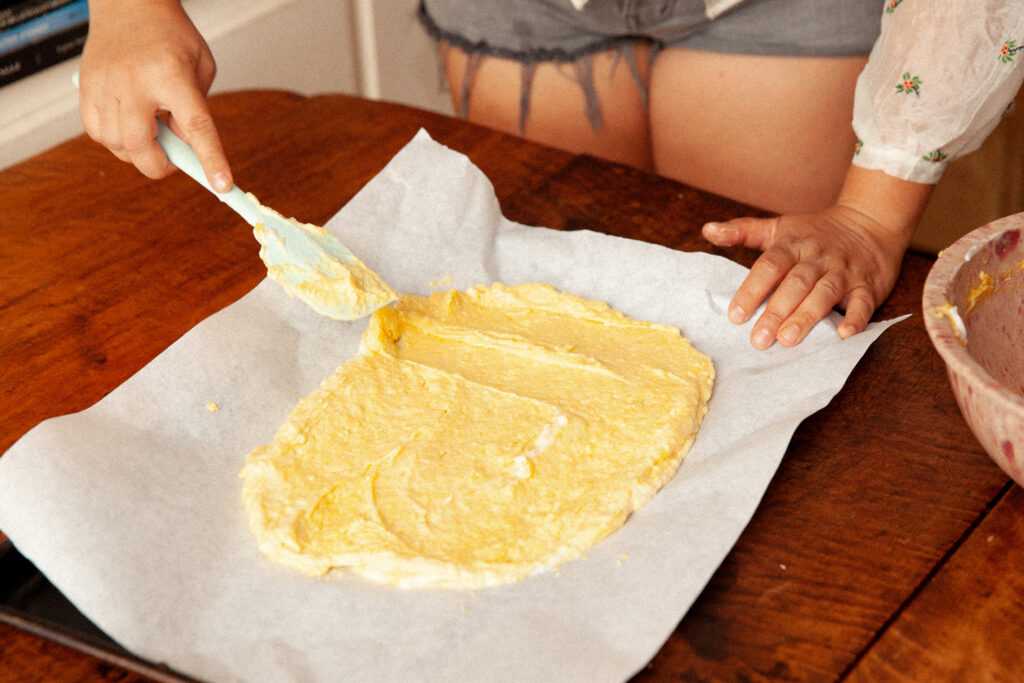
Photograph by Erica Maclean.
Make the mousse. Purée the cherries with the sugar, then add the cherry liquid or cognac and bring to a simmer in a small saucepan. Remove from the heat and allow to cool. Whisk the egg yolks and remaining sugar together in a saucepan over low heat, stirring continuously (your goal is to temper the eggs and prevent them from curdling). When the egg mixture is warm and has begun to look creamy, whisk in about 1/4 cup of the cherry purée and heat through. It should thicken slightly.
Meanwhile, bloom the gelatin: Add two packets to 40 ml of cool water. The powder will expand and become gelatinous. Whisk the bloomed gelatin into the egg-and-cherries mixture, then add the rest of the puréed cherries and mix thoroughly. Allow the whole mixture to cool to room temperature. Do not under any circumstances add the mixture to the whipped cream (next step) before it is completely cool.
Once the egg-cherries-and-gelatin mixture has cooled (or while you are waiting for it to cool), whip the cream into stiff peaks. Gently fold the mixture into the whipped cream, being careful not to knock the air out of the cream. Pour the mousse into a greased, parchment-lined springform pan and transfer to the refrigerator to set. The mousse may set in just a few hours, but I recommend doing this step the night before you want to serve the cake, to avoid anxiety.
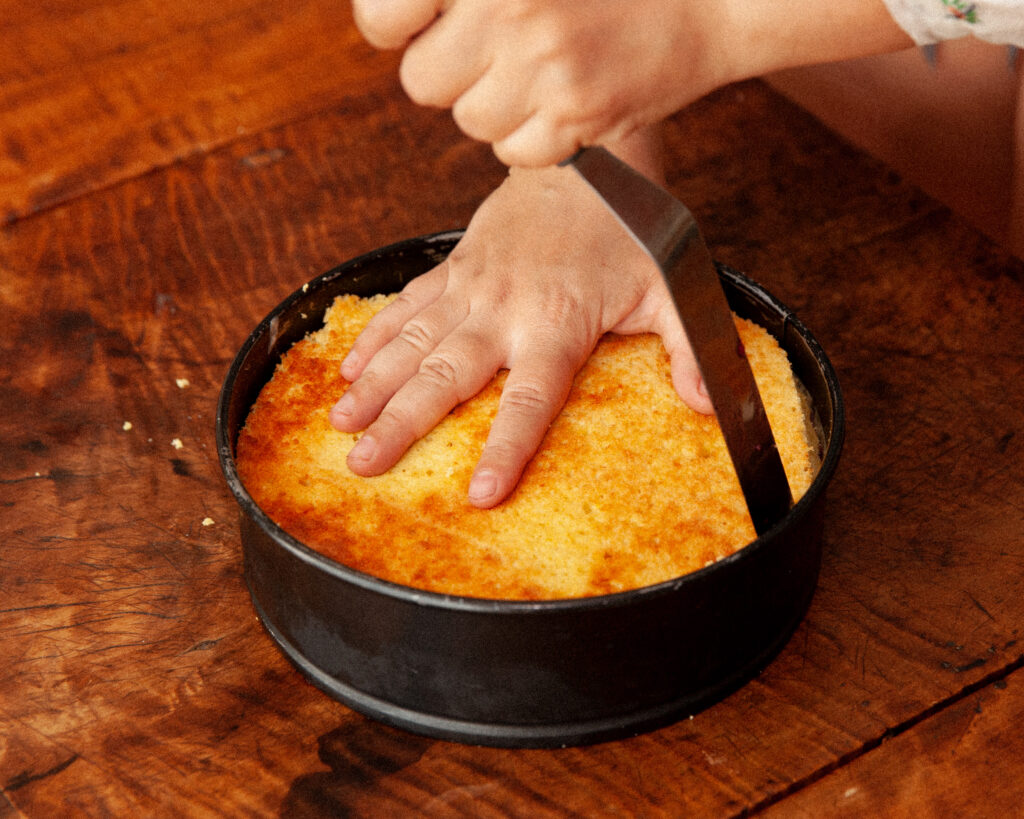
Photograph by Erica Maclean.
Make the cake. Preheat the oven to 350°F. Line a sheet pan with parchment paper. The batter is quite stiff and the cake layer will be thin, so don’t worry too much about lining the sides. You do, however, need to choose a baking sheet that has more surface area than the springform pan you used for the mousse, as you will cut out the cake to the precise size you need after it’s baked.
Add the egg whites and cream of tartar to the bowl of an electric mixer and beat until they form soft peaks. Add the powdered sugar and continue to beat until the meringue forms stiff, glossy peaks. Set aside, and in a separate bowl beat the whole eggs and sugar until light and fluffy, then add the butter, orange blossom water, and orange zest and mix thoroughly. Gently fold in the almond meal and flour, and then fold this mixture gently into your meringue. As with the mousse, be careful not to knock the air out of your batter as you are folding. This cake has no chemical rising agent—it relies on the air trapped in your meringue to make it light and fluffy.
Using a spatula, spread your cake batter out onto your prepared baking sheet. You can make it as thick or as thin as you like; I spread it about one inch thick. You do not need to spread it all the way to the edges of the pan. Bake for fifteen to twenty minutes, or until the top turns golden brown and the cake is firm and springy to the touch. Allow it to cool completely.
To assemble the cake, take your springform pan with the set mousse and place it on top of the almond cake and trace the outline of the pan. Trim your cake in this shape: it should fit nicely into the top of your pan. Next, spread the rest of the cherry purée on top of the set mousse. Prepare a baking dish full of warm water large enough to hold your pan—an inch or two of water will be enough; don’t flood your cake. Place the sponge cake layer on top of the mousse pan, and place the pan in the warm-water bath for thirty seconds. Then place baking sheet on top of the pan and carefully flip it. Working slowly, remove the sides of your springform pan and then the top, being careful not to tear or dent the mousse layer. The mousse should hold its shape. Put in the freezer for thirty minutes or overnight.
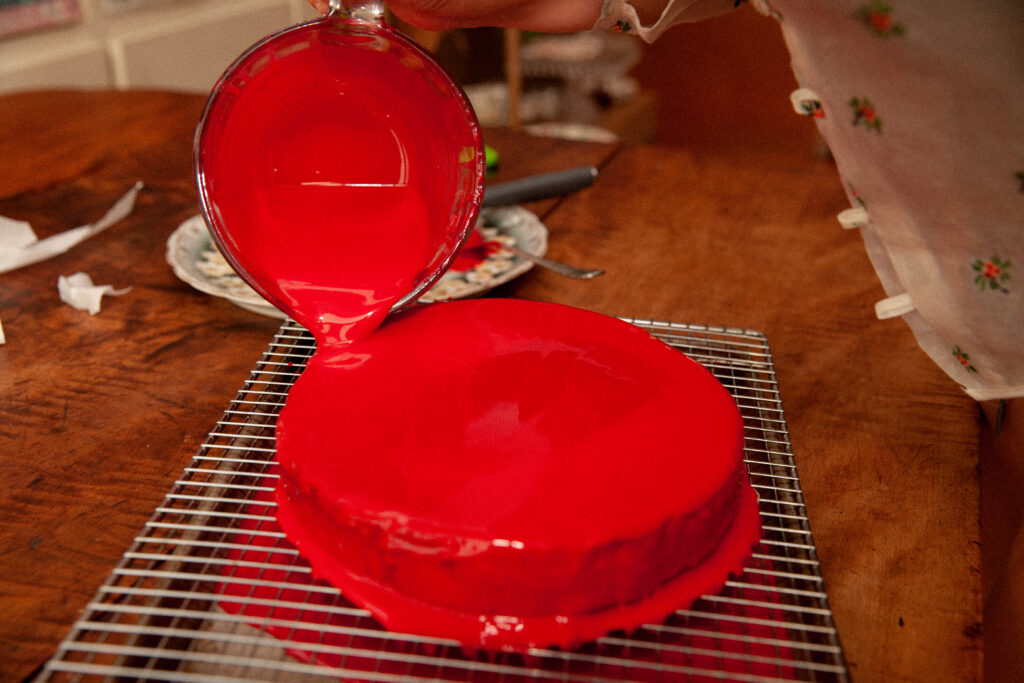
Photograph by Erica Maclean.
Make the mirror glaze. Bloom the gelatin: Mix the gelatin and cold water and set aside until the gelatin expands. Meanwhile, whisk together the condensed milk, water, and sugar in a small pot. Bring to a simmer over medium-high heat, then whisk in the bloomed gelatin until it is fully dissolved and no clumps remain. (I suggest using an immersion blender for this step, but be careful to keep it fully submerged, so you don’t introduce bubbles into the glaze.)
Place the white chocolate in a mixing bowl, then pour the hot gelatin mixture through a sieve over the chocolate. The chocolate should melt completely. Mix with an immersion blender, and add red food coloring until you have a bright, shiny red. Transfer to a vessel that pours easily and allow to cool to 94°F, monitoring the temperature closely. The mirror glaze will set correctly if poured between 90 and 94°F. If it is too hot or too cold, you will not achieve the desired effect.
While you are waiting for the glaze to cool, prepare the mousse cake for glazing. Remove it from the freezer, and using an offset spatula, transfer it to a cake stand or cooling rack set over a baking sheet (the glaze will be messy—you want to catch any drips). When the glaze reaches 94°F, slowly pour it over your cake, starting at the center. The glaze should pool and drip down the sides. Continue to pour until you’ve used all the glaze, taking care to coat the whole cake evenly. The glaze should set within one or two minutes. Once it has set, use the spatula to carefully transfer the cake to a serving platter.
Garnish. I sliced my cherries in half and arranged them on the cake with the pits still in, to look like broken hearts. Cut small pieces of comb honey to go in between them, and garnish with a few red flowers.
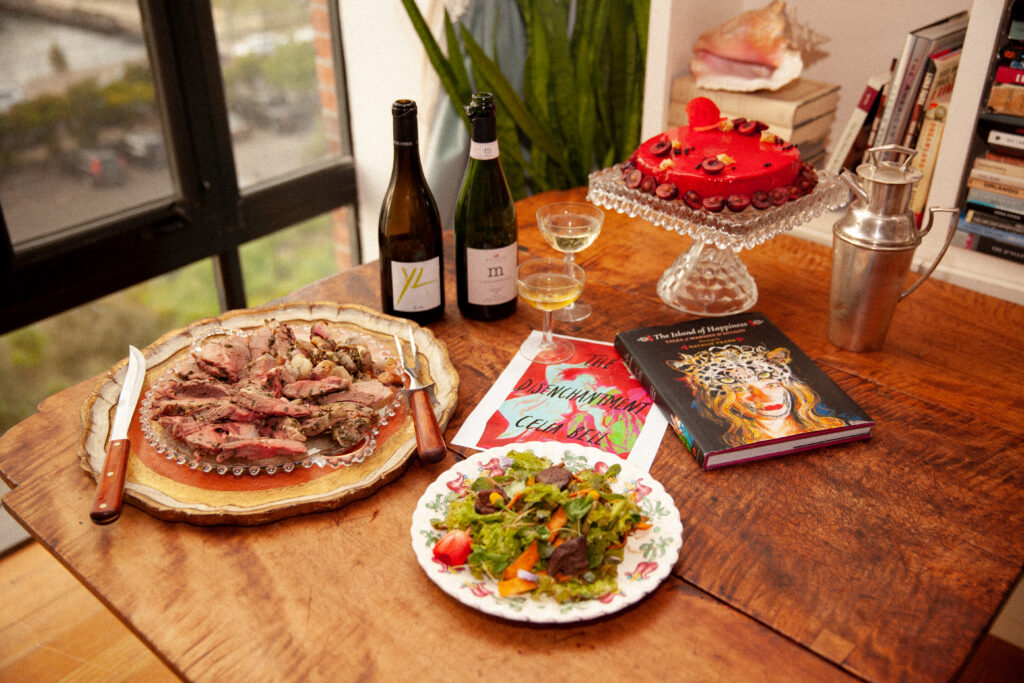
Photograph by Erica Maclean.
Valerie Stivers is a writer based in New York. Read earlier installments of Eat Your Words.
Copyright
© The Paris Review
